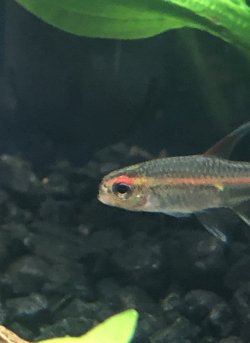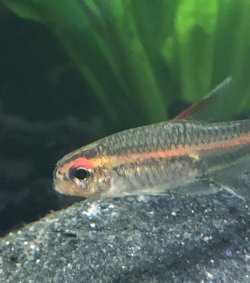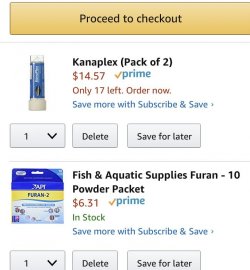Turning the heat down temporarily a little will slow down the fungus too. It likes warm water.
-
Guest, the Tank of the Year contest is underway!
💧 Which tank will win? 👉 View the entries and vote now!!
You are using an out of date browser. It may not display this or other websites correctly.
You should upgrade or use an alternative browser.
You should upgrade or use an alternative browser.
What disease is this!?!?! And what should I do!?!?!
- Thread starter Mateo Vanegas
- Start date
Mateo Vanegas
Fish Fanatic
Ok I will do that right nowTurning the heat down temporarily a little will slow down the fungus too. It likes warm water.
Mateo Vanegas
Fish Fanatic
Ok I added the salt and turned the heat to 72, and only put my tetras back into my 10
What you need to determine is if this issue is strictly external to gills or internal as well. When you are dealing with gill issues ( such as from ammonia toxicity)- the line between internal and external bacterial infection ( and secondary fungus) is a fine one.
You can use the salt, water changes, lower temp ( to slow down spread of bacteria and, therefore fungus) and do a wait and see. But, if you are seeing lethargy or weakness in fish, fish not eating, redness or red streaking around gills denoting infection, I would use an antibiotic. Salt has its value, but once you have an active bacterial infection (especially if becomes septic) salt is a band-aid on a deep wound.
Also, it is worth explaining that this is not a "fungal infection," ~as in a true fungus being the causative agent in this illness. It is a bacterial infection due to ammonia toxicity: damage to gills from ammonia, secondary bacteria spreads among affected tissues, the fungus then spreads among areas of gills where bacteria has proliferated in tissues.
So, in order to make next move ask yourself this:
Any lethargy in fish? Weakness? Difficulty swimming?
Redness/ red streaks that point to internal as well as bacterial condition?
Are the fish eating ( many fish will eat when dealing with external issues, but when goes internal, they will stop eating.)
If all well above- do salt only.
If any of these a issue, this is more serious and need to do antibiotic as well. At 7.5 pH, the kanamycin would be best bet.
You can use the salt, water changes, lower temp ( to slow down spread of bacteria and, therefore fungus) and do a wait and see. But, if you are seeing lethargy or weakness in fish, fish not eating, redness or red streaking around gills denoting infection, I would use an antibiotic. Salt has its value, but once you have an active bacterial infection (especially if becomes septic) salt is a band-aid on a deep wound.
Also, it is worth explaining that this is not a "fungal infection," ~as in a true fungus being the causative agent in this illness. It is a bacterial infection due to ammonia toxicity: damage to gills from ammonia, secondary bacteria spreads among affected tissues, the fungus then spreads among areas of gills where bacteria has proliferated in tissues.
So, in order to make next move ask yourself this:
Any lethargy in fish? Weakness? Difficulty swimming?
Redness/ red streaks that point to internal as well as bacterial condition?
Are the fish eating ( many fish will eat when dealing with external issues, but when goes internal, they will stop eating.)
If all well above- do salt only.
If any of these a issue, this is more serious and need to do antibiotic as well. At 7.5 pH, the kanamycin would be best bet.
Mateo Vanegas
Fish Fanatic
I just feed them and all of them started to dart around and eat, even my worst looking fish was eating, they have no red streaks and none of my fish are lethargic as of right now, they are still schooling.What you need to determine is if this issue is strictly external to gills or internal as well. When you are dealing with gill issues ( such as from ammonia toxicity)- the line between internal and external bacterial infection ( and secondary fungus) is a fine one.
You can use the salt, water changes, lower temp ( to slow down spread of bacteria and, therefore fungus) and do a wait and see. But, if you are seeing lethargy or weakness in fish, fish not eating, redness or red streaking around gills denoting infection, I would use an antibiotic. Salt has its value, but once you have an active bacterial infection (especially if becomes septic) salt is a band-aid on a deep wound.
Also, it is worth explaining that this is not a "fungal infection," ~as in a true fungus being the causative agent in this illness. It is a bacterial infection due to ammonia toxicity: damage to gills from ammonia, secondary bacteria spreads among affected tissues, the fungus then spreads among areas of gills where bacteria has proliferated in tissues.
So, in order to make next move ask yourself this:
Any lethargy in fish? Weakness? Difficulty swimming?
Redness/ red streaks that point to internal as well as bacterial condition?
Are the fish eating ( many fish will eat when dealing with external issues, but when goes internal, they will stop eating.)
If all well above- do salt only.
If any of these a issue, this is more serious and need to do antibiotic as well. At 7.5 pH, the kanamycin would be best bet.
Excellent- just use salt, water changes, lower temp. If you see other signs then can shift gears.
Water quality maintenance and cycling will be your focus. Make sure do at least 25% daily water changes to aid in healing of fish gill tissues. This will go along way in helping fishes immune system to repair gill filaments.
Test water routinely to see where you are on cycling.
Make sure your filter has plenty of biological media to give surface area for bio-filter to build. Your filter may be inadequate.
Water quality maintenance and cycling will be your focus. Make sure do at least 25% daily water changes to aid in healing of fish gill tissues. This will go along way in helping fishes immune system to repair gill filaments.
Test water routinely to see where you are on cycling.
Make sure your filter has plenty of biological media to give surface area for bio-filter to build. Your filter may be inadequate.
Ammonia toxicity does not normally occur overnight. It takes some time to exposure to get to the degree that @Lilyann is speaking of. I don’t believe we are dealing with that at this point. With that being said, I am a strong believer in antibiotics when needed and often get push back from other members who disagree. One more thing, 25% water changes do very little except stir the dirt around. To be effective, you need to do 70% water changes daily for next 10 days. Otherwise, the fish is swimming around in bacteria and waste that he doesn’t need to deal with right now.
Mateo Vanegas
Fish Fanatic
This tetras mouth is open and he won’t close it, it’s almost like it’s eaten away at its mouth,What you need to determine is if this issue is strictly external to gills or internal as well. When you are dealing with gill issues ( such as from ammonia toxicity)- the line between internal and external bacterial infection ( and secondary fungus) is a fine one.
You can use the salt, water changes, lower temp ( to slow down spread of bacteria and, therefore fungus) and do a wait and see. But, if you are seeing lethargy or weakness in fish, fish not eating, redness or red streaking around gills denoting infection, I would use an antibiotic. Salt has its value, but once you have an active bacterial infection (especially if becomes septic) salt is a band-aid on a deep wound.
Also, it is worth explaining that this is not a "fungal infection," ~as in a true fungus being the causative agent in this illness. It is a bacterial infection due to ammonia toxicity: damage to gills from ammonia, secondary bacteria spreads among affected tissues, the fungus then spreads among areas of gills where bacteria has proliferated in tissues.
So, in order to make next move ask yourself this:
Any lethargy in fish? Weakness? Difficulty swimming?
Redness/ red streaks that point to internal as well as bacterial condition?
Are the fish eating ( many fish will eat when dealing with external issues, but when goes internal, they will stop eating.)
If all well above- do salt only.
If any of these a issue, this is more serious and need to do antibiotic as well. At 7.5 pH, the kanamycin would be best bet.
Attachments
Mateo Vanegas
Fish Fanatic
I just got a new one this is a better one than the last one I got and I tore a huge piece of my old filter and put it on my new one to help the bacteria colonizeExcellent- just use salt, water changes, lower temp. If you see other signs then can shift gears.
Water quality maintenance and cycling will be your focus. Make sure do at least 25% daily water changes to aid in healing of fish gill tissues. This will go along way in helping fishes immune system to repair gill filaments.
Test water routinely to see where you are on cycling.
Make sure your filter has plenty of biological media to give surface area for bio-filter to build. Your filter may be inadequate.
Yes, you are right, @Deanasue you are dealing with ammonia's after-effects. The symptoms are clear that the exposure was there- not in the 2.5 gallon tank, but in the 10 gallon tank which OP has had issues with ammonia since adding fish.
I have no problem going directly to antibiotic- that is definitely what I would do in cases of ammonia toxicity of gills. But, others like to be more conservative in their responses.
I have no problem going directly to antibiotic- that is definitely what I would do in cases of ammonia toxicity of gills. But, others like to be more conservative in their responses.
Excellent- just use salt, water changes, lower temp. If you see other signs then can shift gears.
Water quality maintenance and cycling will be your focus. Make sure do at least 25% daily water changes to aid in healing of fish gill tissues. This will go along way in helping fishes immune system to repair gill filaments.
Test water routinely to see where you are on cycling.
Make sure your filter has plenty of biological media to give surface area for bio-filter to build. Your filter may be inadequate.
If it is eating away at him then It’s time to pull out the big guns. Please order some Seachem Kanaplex and API Furan-2 immediately. Too much time has been wasted when this was my recommendation a couple of days ago.This tetras mouth is open and he won’t close it, it’s almost like it’s eaten away at its mouth,
Mateo Vanegas
Fish Fanatic
Ok yes I just got approval that I can buy someIf it is eating away at him then It’s time to pull out the big guns. Please order some Seachem Kanaplex and API Furan-2 immediately. Too much time has been wasted when this was my recommendation a couple of days ago.
So, your diagnosis is what? Why recommend both kanamycin and nitrofurazone?If it is eating away at him then It’s time to pull out the big guns. Please order some Seachem Kanaplex and API Furan-2 immediately. To much time has been wasted when this was my recommendation a couple of days ago.
Mateo Vanegas
Fish Fanatic
Mateo Vanegas
Fish Fanatic
Similar threads
Most reactions
-
 348
348 -
 159
159 -
 141
141 -
 140
140 -
 139
139 -
 117
117 -
 110
110 -
 104
104 -
 96
96 -
 82
82 -
 71
71 -
 61
61 -
 56
56 -
 54
54 -
F
49



